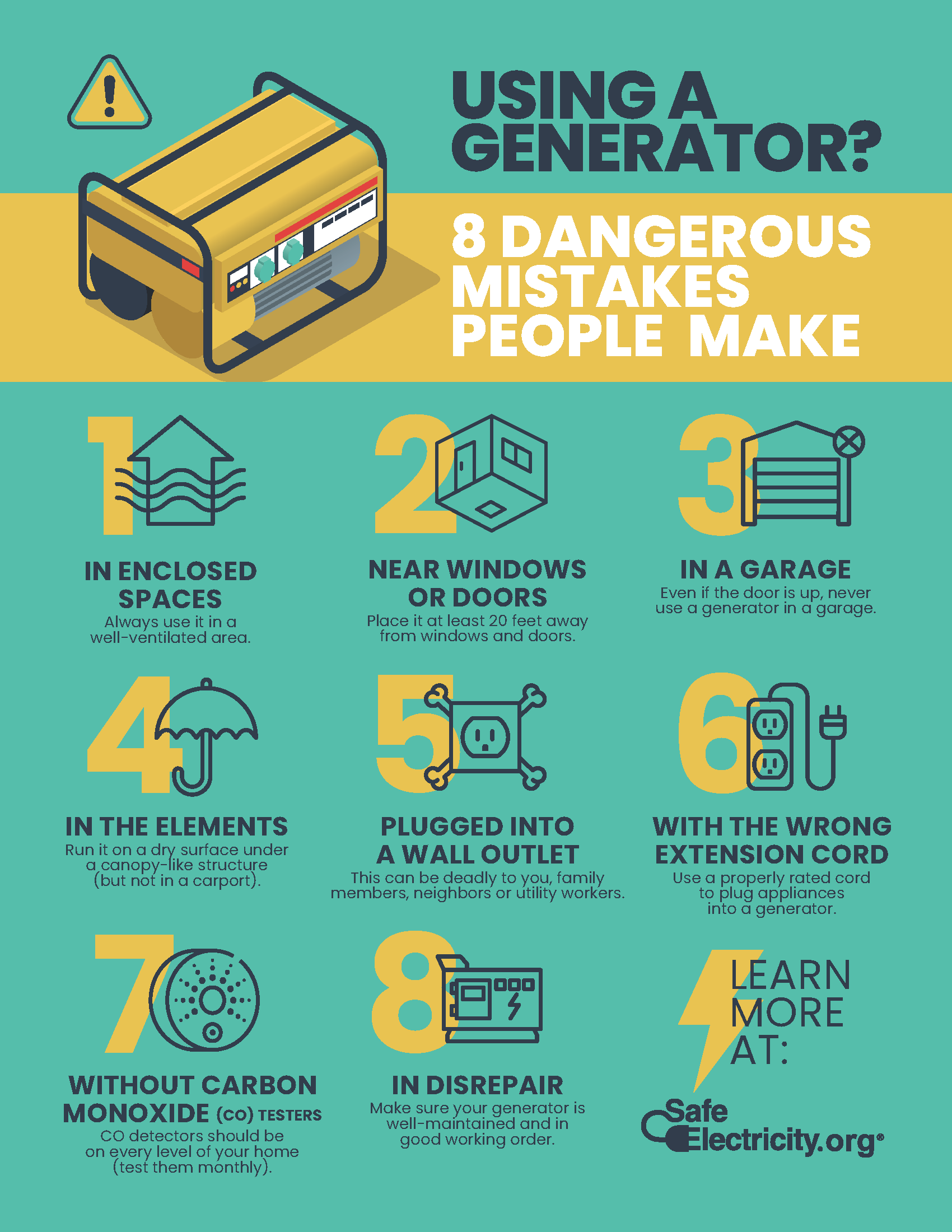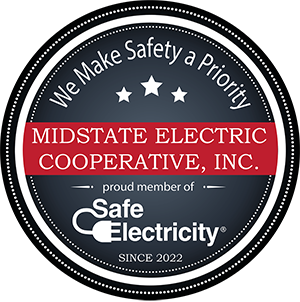Think Safety When Operating a Generator
A generator can be a valuable piece of equipment to keep appliances working during a power outage. Generators can be either temporary or permanently installed.
A permanent generator is wired into a house by a qualified electrician using a transfer switch that prevents a generator from feeding electricity back into overhead lines, which can be deadly for linemen.
A temporary generator is powered by gasoline and should not be attached to a circuit breaker, fuse, or outlet. Before ever purchasing a generator you need to know the wattage required to run the appliances you will attach to the generator. You also need to know the surge power, which is the power it takes to turn an appliance on.
Once you have purchased the proper generator, follow these tips from Safe Electricity to properly operate your generator:
- Read and follow all manufacturer operating instructions to properly ground the generator. Be sure you understand them before hooking up the generator.
- Never operate a generator in a confined area, such as a garage. Generators can produce numerous gases, including toxic and deadly carbon monoxide. They require proper ventilation.
- Generators pose electrical risks especially when operated in wet conditions. Use a generator only when necessary when the weather creates wet or moist conditions. Protect the generator by operating it under an open, canopy-like structure on a dry surface where water cannot form puddles or drain under it. Always ensure that your hands are dry before touching the generator.
- When you refuel the generator, make sure the engine is cool to prevent a fire, should the tank overflow.
- There should be nothing plugged into the generator when you turn it on. This prevents a surge from damaging your generator and appliances.
- Be sure to keep children and pets away from the generator, which could burn them.
- Shut down the generator properly. Before shutting down a generator, turn off and unplug all appliances and equipment being powered by the generator.
- Remember maintenance between uses. It is also a good idea to inspect the fuel and oil filters, spark plug, oil level and fuel quality and to start the generator on a regular basis before an emergency situation occurs.
For more information on electrical safety, visit SafeElectricity.org.

Shopping for a Generator? Do a Little Homework First
Generators are classified by how much power or watts they can produce. That wattage measurement is important because it determines how many devices you can power. According to Consumer Reports (CR), the typical home requires 5,000 watts to cover the basics.
When considering which generator to buy, decide what you can’t live without when the power is out. Then add up the wattages to get an idea of how much power you will need.
For example, a refrigerator typically takes 600 watts to run; a sump pump requires 750 to 1,500 watts; a portable heater can take 1,500 watts; and lights can require from 60 to 600 watts (depending on how many you power and the size of your home).
Safe Electricity and Midstate Electric offer background on four types of supplemental power sources:
- Portable Generator
Because these usually run on gasoline, they are extremely dangerous since they can produce carbon monoxide (CO). Because of that, never run these indoors or in an enclosed space and always keep them at least 20 feet from your home when operating them. Additionally, do not use them in damp or wet conditions. Some newer models feature a built-in CO sensor that triggers an automatic shut-off feature if it detects CO buildup. Other advanced models are designed to emit less poisonous fumes; both of these safety features help to save lives. Prices range from $400 to $1,000.
- Inverter Generator
This type of generator has a more complex engine than its portable cousin. Because of that, inverter generators usually cost more than portable versions. They are much quieter than portable generators since they throttle up and down to match demand (instead of running at constant full power). They also boast more advanced exhaust systems, which also helps with noise levels. Inverter generators typically cost $500 to $4,000, and if you pick this kind of generator, you should follow the same safety precautions you would with a portable version.
- Standby Generator
This is the most expensive type of generator and models range from 5,000 to 20,000 watts. Standby generators are also the most convenient, since they are permanently mounted, and they kick on automatically when the power goes out. They run on propane or natural gas and cost $3,000 to $6,000, not including installation. Installing them is definitely not something you can do yourself; they should be installed by an experienced electrician.
- Portable Power Stations
These stations don’t use gasoline or propane; instead, they are powered by a battery that can be charged by electricity or by a solar panel. They cost more than traditional portable generators at $750 to $3,000. They are extremely quiet, and they don’t produce fuel emissions so you can use them indoors. The downside is they don’t power as many appliances as portable generators, and they don’t run for an extended period of time.
For more information about electrical safety, visit SafeElectricity.org.

